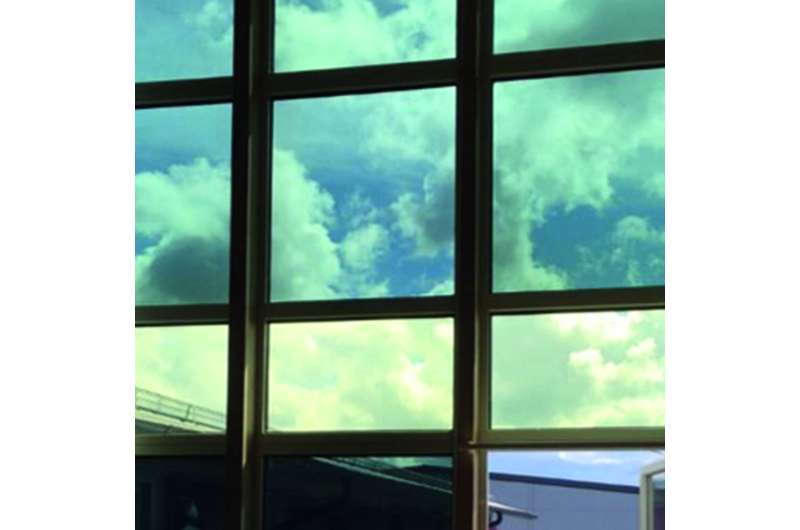Visual comparison between electrochromic windows in non-switched (bottom) and switched (top) state. Credit: ChromoGenics AB, Sweden; Picture in printable resolution: www.fep.fraunhofer.de/press
Glass facades characterize modern architecture. While solar radiation serves to support heating in winter, the building interior heats up in summer and requires active cooling. Smart windows can regulate the solar radiation according to the weather situation—a forward-looking solution in times of energy saving. Fraunhofer FEP has now succeeded in producing the world's first thermochromic layer on ultra-thin glass in a roll-to-roll process. These results will make mechanical blinds superfluous in the future and at the same time reduce the cooling and heating energy requirements of a building.
Office complexes, public buildings and new buildings are mostly architecturally characterized by large, south-facing windows and glass facades. While solar radiation serves to support heating in winter, the interior of the building heats up in summer and requires active cooling. Shading by means of blinds, for example, reduces comfort and does not contribute to the use of heat input in the building in winter. Especially in view of the coming autumn and winter period combined with the current government requirements for energy saving and the energy crisis, smart windows offer a highly attractive solution here. Such windows can regulate the heat input of solar radiation according to the weather situation.
Coating technologies for thermochromic and electrochromic coatings
Fraunhofer FEP is researching on surface coatings that can make a major contribution here and enable a reduction in heat radiation through window glass into the building. Our researchers are working together with project partners, for example in the EU project "Switch2Save" on active, smart coating systems that use the effects of electrochromism (switching of energy transmission by applying a voltage) and thermochromism (switching of energy transmission by exceeding/falling below a temperature). Such electrochromic films can be used in insulating glazing and are not only used in new buildings. Retrofitting of existing buildings is also possible and is the subject of the recently launched "FLEX-G4.0" project
Currently, some passive technologies, such as SolarControl systems and low-E coatings (low emissivity) are already commercially available on the market. However, these thin coatings produced on foil or glass only lead to a permanent adjustment of the energy transmittance. They therefore only work in one setting, e.g., to prevent heat radiation in summer. In winter, however, this is kept out in the same way. In addition, they also make use of expensive resources such as silver in the manufacturing process. The Fraunhofer researchers are therefore focusing on optimizing the properties and replacing such scarce materials.
With all technologies—whether passive (low-E; SolarControl) or active (electrochromic; thermochromic)—the challenge is to master the balancing act between the different properties that are to be effective at the same time: Do the optical impression and the optical effectiveness in different wavelength ranges play the greater role or is this negligible compared to a large energy transmittance. Likewise, the range of switching temperatures for thermochromic coatings and, of course, the manufacturing costs must also be considered.
In order to find versatile and new solutions for this, researchers at Fraunhofer FEP are currently developing coating technologies for thermochromic elements on ultra-thin glass. The substrate material with a thickness of approx. 100 µm places high demands on handling and scaling to larger areas has so far proved very difficult. At the same time, the use of a polymer film as an alternative substrate, which could facilitate handling, is not feasible without further ado. The reason for this is the high temperatures in the manufacturing process.
First thermochromic coatings on thin glass in roll-to-roll process worldwide
In early 2022, researchers at Fraunhofer FEP succeeded in producing the world's first thermochromic layer based on vanadium dioxide on ultra-thin glass using the efficient roll-to-roll technology. Dr. Cindy Steiner, group leader at Fraunhofer FEP, is pleased: "We have thus taken an important step in scaling the technology from laboratory to pilot scale with our roll-to-roll equipment! The thermochromic coatings change their transmission in the infrared range when a certain temperature is exceeded. The transmission in the visible range remains unchanged. Thus, the user does not notice any optical change in the window and has no restrictions in light comfort or visibility. This effectively blocks heat radiation in summer, reducing the need for air conditioning. In winter, heat radiation from the sun is allowed to pass through, resulting in savings in heating energy consumption."
The switching temperature is around 20°C, which means that the thermochromic thin glass attached to buildings switches between the transmissive and reflective state when it warms up above 20°C." This switching temperature can be adjusted according to climatic requirements through the composition, process control and structure of the layer system," adds Dr. Steiner.
In the next step, the technology is to be scaled up and brought to market maturity. Research topics are in particular the optimization of substrate handling, long-term stability and the adjustment of the required switching temperature.
The combination of technologies presented here makes mechanical blinds superfluous in the future and can reduce a building's cooling and heating energy requirements by between ten and, in extreme cases, up to 60%.
Provided by Fraunhofer-Gesellschaft
























